| |
On Sunday, we went bowling as part of a group event. Bowling in Japan is no different from bowling in the States, down to the clownish rental shoes. 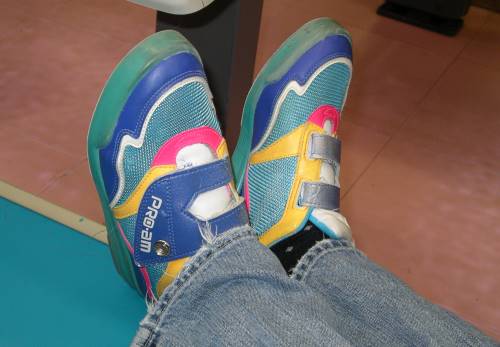 We haven't gone bowling in a very long time, so it took us a few frames to get back into it. Our team actually did pretty well ― three of us broke 100 on the first game, and we all did on the second. The event was a fundraiser for the local sign language club, some of whom we've met through local friends. In between turns, they were teaching us little bits of Japanese Sign Language, including the signs for "Washington" and "America." As it turns out, the frowny face accompanying a blown spare is an international sign. At the end of the tournament, the group gave prizes to each participant, ranked from highest score to lowest; I think we were all in the top twenty. Also, people who threw gutter balls had the dubious distinction of getting extra prizes based on the number of gutters thrown. Matthew got one: 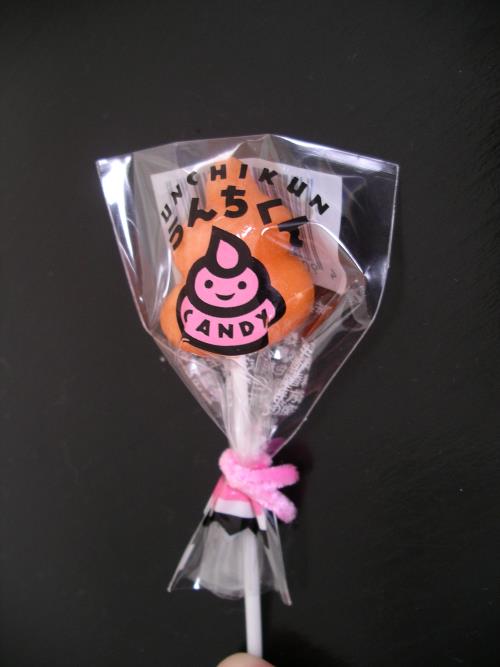 Yes, it's candy poop on a stick. A lollipoop, if you will.
Thursday, January 24, 2008, 6:54 PM GeneralPosted by stefanie According to our local friends, January 21 was Daikan ― the coldest day of the year on the Japanese calendar. The two weeks surrounding Daikan are also supposed to be colder than the rest of winter, which is easy to believe. Many roads in town resemble skating rinks because temperatures have gotten just above freezing during the day, but it hasn't been warm enough to evaporate the snowmelt. Riding your bike on these roads is quite treacherous; I've taken some spills in the last week or so.
The Japanese have different ways of dealing with winter weather than we've experienced in America. It's common to see cars sitting with their windshield wipers standing out. People do this so that they won't freeze to the windshield, which totally makes sense if you've ever tried to prise frozen rubber away from glass. In Kitakami, street crews don't salt or sand the roads ― driving precautions are up to individuals. Almost everyone has snow tires or chains. Roads aren't graded down to the asphalt. As far as we can tell, they're not really graded at all, but harvested. Snow is clearly removed from them because the level on the roads is lower than that in yards and parking lots, but a layer is still there and there aren't piles of gray, dirty snow lining the streets. The result is that even two or three weeks after a big snowfall, the landscape is still quite beautiful, if the roads are a bit more dangerous than we're used to. It's not a bad trade-off.
[ 1 comment ] permalink
Tuesday, January 22, 2008, 2:36 PM GeneralPosted by stefanie On Saturday, the Kitakami International Assembly Hall hosted its Shinnenkai, an introduction to Japanese culture. Attendees could try out a range of traditional activities, from tea ceremony to shodou (Japanese calligraphy) to koto (Japanese zither). Matthew is interested in learning shodou, so he got a quick lesson. 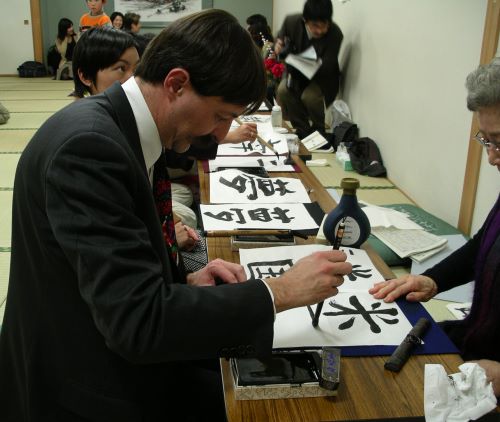 We also tried koto and shakuhachi, Japanese bamboo flute. Our trial was featured in a photo in the Sunday newspaper, which unfortunately is not available online. Each group also put on a demonstration. The tea ceremony practitioners prepared the traditional New Year's tea, which contained a pickled plum and a tied bit of seaweed. The tea was served with youkan and black bean and walnut mochi. 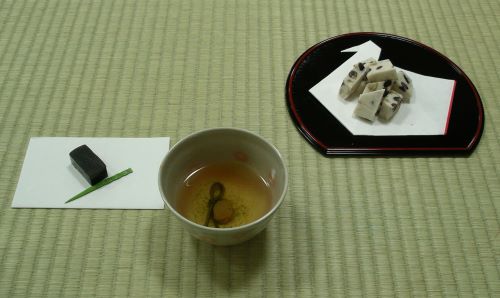 One of the more energetic groups performed a type of Japanese street entertainment. They chanted a folk tale while dancing with props resembling small bamboo fences that they could manipulate into different forms. 
New Year's in Japan seems to be an ongoing celebration throughout the month of January. Shinnenkai, or New Year's gatherings held after January 1, bring people together to share in the optimism of the fresh year ahead and to partake in traditional events. We were invited to one such event last week, mochitsuki. As we've mentioned before, mochi is one of the traditional Japanese New Year's foods. Mochitsuki is the traditional mochi-making ceremony, during which members of the community use large wooden mallets to pound polished, cooked rice into a sticky paste. Once the paste is made, it is formed into small cakes, which can then be eaten. At the encouragement of our hosts, we took a turn kneading the mochi with the giant mallets. 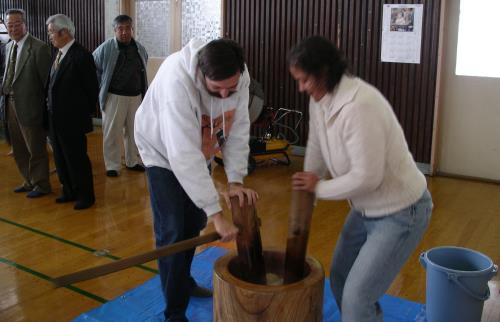 It was fun, but we clearly lacked the energy and expertise of the locals. 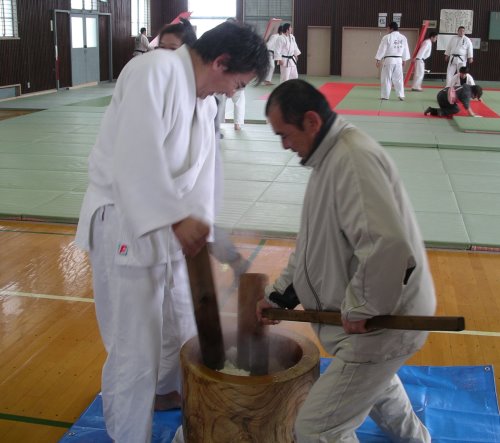 Once the kneading was completed, people alternated pounding the rice with a quick water rinse to keep it from sticking to the equipment. Children, assisted at times by their parents, got in on the pounding too. It was a great community event; one that we're glad we went out into the white-out conditions for.
J-Life Lesson #46: When living in a part of the country where it snows every day during the winter, check frequently on your air-drying laundry. 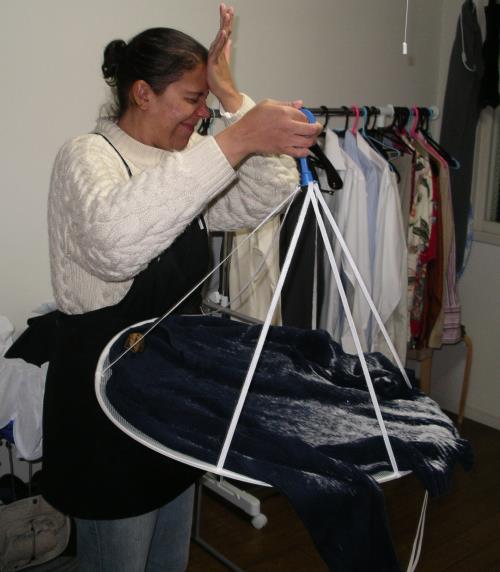
Let's take a look at today's weather, shall we? Here's the weather report. It's pretty typical for winter in Tohoku: snow in the morning, and cloudy all day after that. 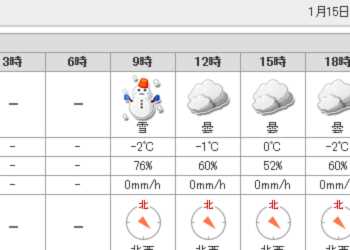 Now, let's take a look out the window: 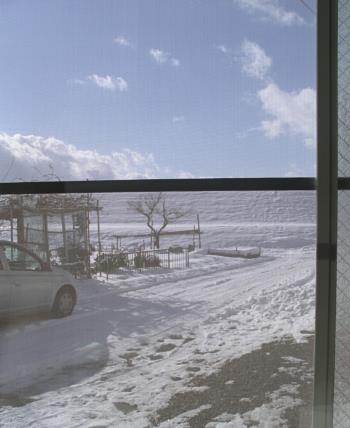 That's about how it goes with the weather forecasts here. They aren't just inaccurate, they're willfully dishonest, or at least it seems so. My theory is that the weathermen are part of a secret government program to emotionally control the people and prevent revolt. When it's nice out (or will be), the forecast shows nasty weather, so that everyone gets a pleasant surprise and is happy. When it's nasty out, the forecast shows nice weather tomorrow or the next day, which gives people hope (even though the nice weather doesn't actually arrive until three weeks later).
Tuesday, January 15, 2008, 1:29 AM General, FoodPosted by matthew At dinner with friends the other night, the topic of horseradish came up. This left our Japanese friends at a loss, as they'd never heard of the stuff. We tried to explain, "it's like wasabi, but it's white. In fact, we call wasabi, 'Japanese horseradish' in English."
A quick dictionary consult, and we had found the Japanese name for horseradish: seiyou wasabi (西洋わさび) — literally, "Western wasabi".
[ 3 comments ] permalink
Tuesday, January 8, 2008, 8:27 PM GeneralPosted by stefanie About a month ago, during one of the early snows in Kitakami, I was chatting with a woman who had lived here for many years. We agreed that the weather was quite bleak, then she put on her ganbarimasu! face and said: "Now is the time when Kitakami becomes a frozen city." The mountain gods must have disagreed with that assessment, for that particular snow didn't last very long.
January, it seems, is the time when Kitakami becomes a frozen city. Since New Year's Day, we've had a couple more brief snows that covered the residual snow from that storm. Thin layers of ice cover the snow in the mornings, and bands of ice have spanned the Waga River at times. The snow remains a few inches deep in many spots, which seems to irritate Moki on walks ― he dislikes having to slog through the snow. The roads are mostly cleared, but there are still patches that turn to slush during the day and back to thick sheets of ice at night.
Even more telling was the bit of ice that fell off my Docs in the car during my store run this afternoon. I hopped back into the car after my stop at the grocery, and this ice clump, which apparently fell off en route, hadn't melted AT ALL. Given that, I felt pretty comfortable leaving the fish necks I'd just bought in the car during my kerosene and dog food stop.
According to the weathermen (who are an entirely different blog post), the low in Kitakami this evening is supposed to reach -8 Celsius tonight. Now is the time when we put on our ganbarimasu! faces, throw on another layer of clothes, and discover life in the frozen city.
[ 3 comments ] permalink
Monday, January 7, 2008, 12:38 PM GeneralPosted by matthew We had snow on New Year's Eve and New Year's Day, with enough accumulation that the embankment near our house became attractive to youngsters wanting to sled or build snowmen. And to us, too. On the 2nd, we gave in to temptation and went to play in the snow. Atop the hill there were already two squat Japanese-style (two-ball) snowmen. There was still plenty of snow, so we decided we'd build a western-style snowman with three balls. And not only that, we'd make it huge! To make a big snowman, you need some big snowballs. Of course you have to start small. 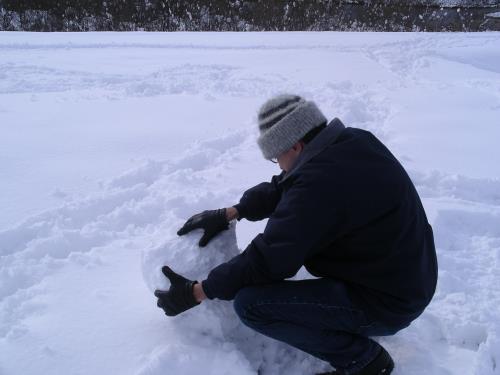 As you roll it around, it gets bigger. You can grow your snowball faster if you don't restrict yourself to rolling up only snow. 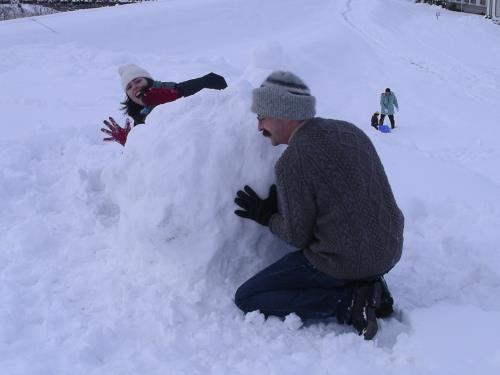 Eventually the snowball got big enough that it took two of us to roll it, then all three of us. We maneuvered it into place to be our snowman base. The torso and head snowballs went much faster, and before long we had a friendly snowman with gravel eyes and wearing Matthew's hat. 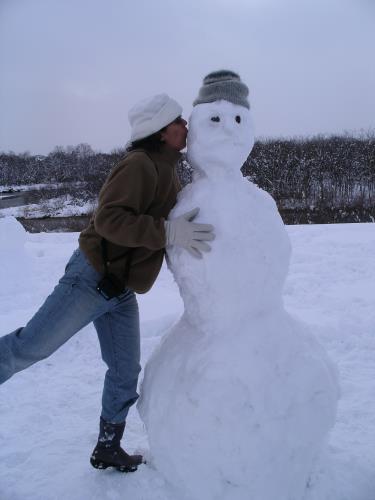 Then Matthew took his hat back. On our way home, we noticed the snowman seemed rather ominous. He towered at the top of the hill, looming over the neighborhood, menacing all with his beady eyes. 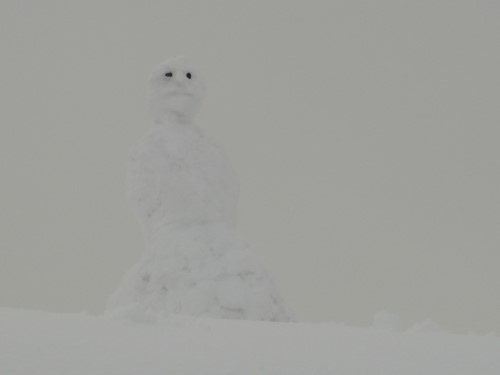 That photo doesn't really capture the feel of it, though. There just wasn't enough contrast between the snowman, ground, and sky. Thanks to the miracle of computers, though, we were able enhance the image so you can see what we mean. 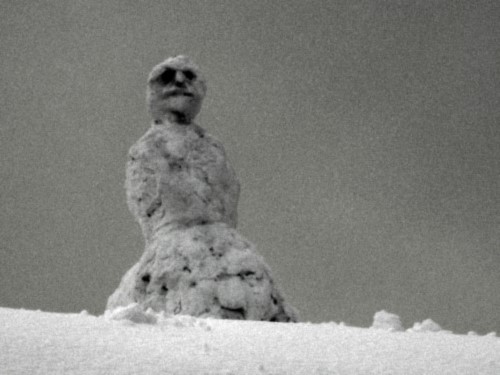 His reign was not to be a long one, though. The next day, some kids took him apart with a shovel and tried to roll the base snowball some more, but found it to be too heavy. For a different account of this adventure, be sure to read Please Take Recess.
[ 4 comments ] permalink
Visiting shrines and temples is an important tradition for New Year's. At large temples, people go on New Year's Eve, and the temple bell sounds 108 times to ring in the new year. Other people arise early, and welcome the new year by visiting a shrine or temple at sunrise. In any case, most people go sometime in the first three days of January. This visit is called hatsumoude. Our nearest shrine, perhaps in recognition that no one wants to be up at dawn in Tohoku in winter, invited the people of the surrounding neigborhoods to visit at 8 am on New Year's Day. We figured this would be a good way to enjoy an old tradition. So, despite our late night the night before, we got up early and made the snowy trek to the shrine grounds. There we found bonfires, friendly greetings, fish paste, and sake. From time to time someone would approach the shrine itself to make an offering and prayer, but mostly it was conversation, drinking, and eating around the bonfires. We ran across several people who remembered us from undoukai. People also wrote their prayers for the new year on paper or wood, which they threw into the fire. The rising smoke carries the prayers up to the gods. 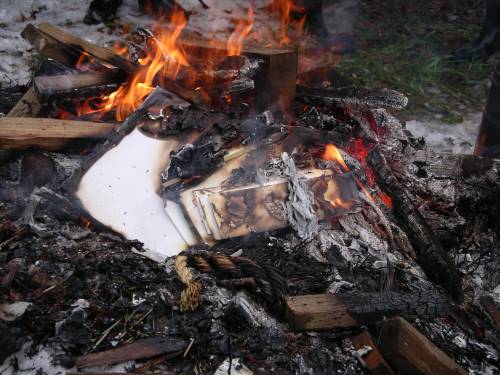 After we were there a short time, a group of men were leaving, and insisted we should go with them. We were uncertain, but they seemed friendly enough, so off we went. Along the way, we learned that our destination was a nearby temple, where there would be more sake, fire, and food. Also along the way, we overheard this exchange (in Japanese): "It's fun bringing the gaikokujin (foreigners) with us." "Don't call them gaikokujin. Call them nakama (good friends)." The temple was one very close to our house, and it was beautiful in the snow. 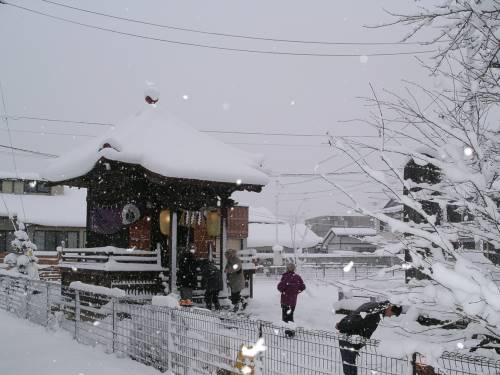 We paid our respects at the altar, then enjoyed more sake along with some snacks, and listened to our new friends speaking in the Tohoku dialect. Before everyone returned home to enjoy osechi ryouri, we got a group photo. 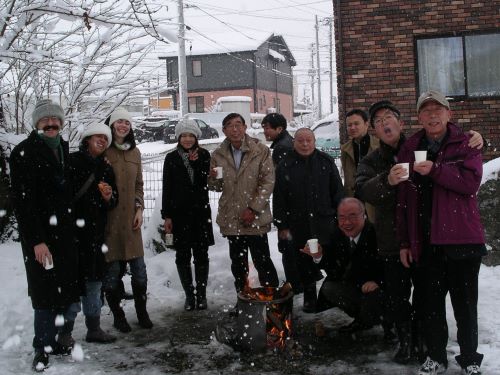 It was an auspicious start to the new year, and left us feeling warm inside.
Back Next
|
|




















 Calendar
Calendar




